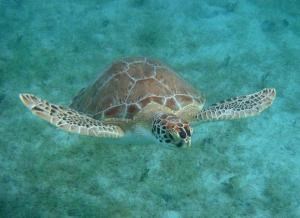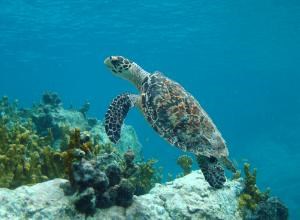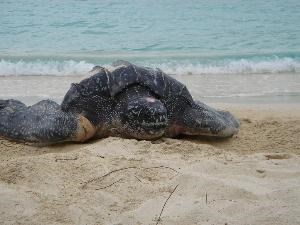Did you know?Turtles are a protected species. Anyone caught touching, riding or disturbing a turtle will be subject to fines up to $5,000 and imprisoned for not more than 6 months. BackgroundThere are seven species of sea turtles in the world, and three of these inhabit the waters of St. John. The two most common are the green and hawksbill turtles, while the leatherback is rarely seen. Sea turtles spend most of their lives in the water only coming ashore to nest. Turtles travel thousands of miles a year. Visit the Sea Turtle Conservancy web site to see where they go. Local Lore:Trunk Bay beach is named after the leatherback turtle because they used to nest there in large numbers. But wait –they are called leatherbacks but the bay was named Trunk Bay. Why? Leatherbacks when on the ocean surface look like a steamer trunk floating so the Danes and locals called them trunk turtles, so the story goes. Virgin Islands Species
Photo © Caroline Rogers, all rights reserved. Green (Chelonia mydas)The green sea turtle can reach almost 40 inches in carapace length (top shell), weigh up to 500 pounds and feeds on sea grasses. They reach sexual maturity between 20-50 years. The green is the largest of all the hard-shelled turtles. They typically nest between June and September. During the season they lay about five nests (clutches), one every two weeks, and it takes about two months for the eggs to hatch. 
Hawksbill (Eretmochelys imbricata)Hawksbill turtles are the smallest of the sea turtles that frequent our waters. A mature hawksbill will weigh between 100 - 150 pounds and measures about 25 inches in length. Female hawksbills return every two to three years to the beaches they were born on to lay their eggs. They lay three to five nests per season with about 130 eggs each. Hawksbill turtles range throughout the trpoical regions of the world. The hawksbill has a distinctive and beautiful shell (carapace). They were harvested almost to extinction for their shell, which was used to create jewelry, combs and brushes. Their diet includes sponges, other invertebrates, and algae. They can be found along rocky ledges and coral reefs where they seek shelter. 
Leatherback (Dermochelys coriacea)The leatherback is the largest of the sea turtles and gets its name from its leathery like dark grey or black shell with whitish spots. It is the only sea turtle to lack a hard shell. These pelagic (open ocean) turtles have seven distinct ridges running the length of its carapace (shell). The leatherback is typically 4 to 6 feet long and weighs 600 to 1100 pounds. The largest leatherback ever recorded was almost 10 feet long and weighed 2019 pounds. They nest every two to three years, four to seven times a season, and lay an average of only 80 eggs. The eggs take about 65 days to hatch. Leatherbacks feed on jellyfish. ThreatsSea turtles face several threats such as recreational boating, commercial fishing, marine pollution, habitat modification, and poaching. Due to these threats, and more, all species of sea turtles are listed under the Endangered Species Act. How can you help protect sea turtles?
Check out the North Florida U. S. Fish & Wildlife page on how you can help protect sea turtles. Sea Turtle Stories |
Last updated: September 21, 2021
